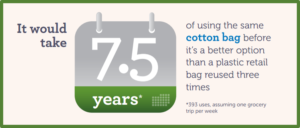Plastic Bags and the Environment
Plastic bags are the most environmentally friendly option at the checkout. They’re 100% recyclable and highly reused. Studies show that alternatives which seem “greener” actually place a greater burden on the environment because they require more natural resources to produce and transport, they emit more carbon throughout their lifecycles and they need more energy to recycle – if they’re recyclable at all. On top of that, studies show bag bans and taxes haven’t meaningfully reduced overall litter or waste anywhere they’ve been tried. ¹

- ENERGY SAVINGS: Plastic bags require 70% less energy to manufacture and consume 96% less water than what’s used to make paper bags.
- DISPOSAL ADVANTAGES: Once disposed, reusable bags take up to 9.3% more space than plastic bags in landfills.
- REUSABLE COTTON BAGS AREN’T REUSED ENOUGH: Standard reusable cotton grocery bags must be reused at least 131 times “to ensure that they have lower global warming potential than” a plastic bag used only once.² In fact, one study found that organic cotton bags need to be reused 20,000 times to have the same environment performance of a plastic bag reused once.³
- NO OIL INVOLVED: American-made plastic bags are produced from byproducts of natural gas, not oil.⁴
The results are in: Bag bans and taxes don’t help to reduce waste, litter, or marine debris.
Ban and tax ordinances have never been successful at meaningfully reducing litter, waste or marine debris. Not anywhere. What they have been shown to do is heap unfair costs on low and fixed-income families and add more red tape to local businesses. The environment doesn’t benefit, and neither do people.
- LANDFILL WASTE INCREASES: According to the EPA, “plastic bags and sacks” account for 0.3% of municipal solid waste.⁵ Plastic retail bags are a fraction of this number. Without plastic grocery bags, people purchase replacement bags — often made of thicker, heavier plastic — and then send those bags to the landfill instead.⁶
- In Austin, landfill waste increased after a bag ban because shoppers used and disposed of thicker plastic reusable bags in the place of standard plastic grocery bags.⁷
- LITTLE TO NO IMPACT ON OVERALL LITTER: Plastic retail bags comprise a very small portion of litter – typically less than 1% – making bans and taxes ineffective when it comes to reducing overall litter.⁸
- In Washington, D.C., a bag tax hasn’t improved litter or reduced bag use at all.9 According to a Washington Post investigation, D.C. collected roughly $10 million since 2010 without making any environmental progress. And the tax revenue keeps growing every year.10
- A year after California implemented a statewide ban on plastic bags in 2016, an Ocean Conservancy survey showed a negligible 0.2% decrease in plastic bag litter as a percentage of overall litter.11
- UNINTENDED CONSEQUENCES:
- California’s plastic bag ban led to an increase in carbon emissions due to a surge in trash bag purchases (which use more plastic than traditional retail bags) as well as an increase in paper bag usage.12
- In Thurston County, Washington, a bag ban resulted in double the use of more resource-intensive paper bags.¹³
- Environmental Protection Agency, “Advancing Sustainable Materials Management: Facts and Figures,” April 2016.
- U.K. Environmental Agency, “Life Cycle Assessment of Supermarket Carrier Bags,” February 2011.
- Ministry of Environment and Food of Denmark, Environmental Protection Agency, “Life Cycle Assessment of grocery carrier bags,” February 2018.
- U.S. Energy Information Administration, “How much oil is used to make plastics?” April 2016.
- United States Environmental Protection Agency, “Advancing Sustainable Materials Management: 2015 Tables and Figures,” July 2018.
- The Scottish Government, “Proposed Plastic Bag Levy – Extended Impact Assessment,” August 2005 and The Advertiser, “Bin line sales double nation average after plastic bag ban,” August 2011.
- Austin Resource Recovery, “Environmental Effects of the Single Use Bag Ordinance in Austin, Texas,” June 2015.
- Environmental Protection Agency, “Advancing Sustainable Materials Management: 2014 Tables and Figures,” December 2016.
- The Washington Post, “Tax data cast doubt on claims about declining use of plastic bags in D.C.,” January 2014.
- The Washington Post, “Is D.C.’s 5-cent fee for plastic bags actually serving its purpose?” May 2015.
- Ocean Conservancy, “Together for our Ocean: International Coastal Cleanup 2017 Report,” 2017.
- Journal of Environmental Economics and Management, “Bag leakage: The effect of disposable carryout bag regulations on unregulated bags,” January 2019.
- Thurston County Solid Waste, “Bag Ordinances: Six Month Implementation Report,” February 2015.

